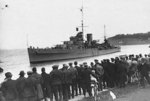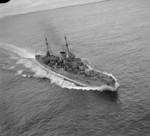Neptune
| Country | United Kingdom |
| Ship Class | Leander-class Light Cruiser |
| Hull Number | 20 |
| Builder | Portsmouth Naval Dockyard, England, United Kingdom |
| Laid Down | 24 Sep 1931 |
| Launched | 31 Jan 1933 |
| Commissioned | 12 Feb 1934 |
| Sunk | 19 Dec 1941 |
| Displacement | 7,050 tons standard; 9,000 tons full |
| Length | 555 feet |
| Beam | 5 feet |
| Draft | 19 feet |
| Machinery | Four Parsons geared steam turbines, six Admiralty 3-drum oil-fired boilers, four shafts |
| Power Output | 72,000 shaft horsepower |
| Speed | 32 knots |
| Range | 5,730nm at 13 knots |
| Crew | 680 |
| Armament | 8x6in Mk.XIII guns, 8x102mm Mk.XVI guns, 2x4x2pdr pom-poms, 12x0.5in machine guns, 8x533mm torpedo tubes |
| Armor | 102mm belt, 64mm ends, 32-51mm deck, 25mm turrets |
| Aircraft | 1 Supermarine Walrus biplane |
| Catapult | 1 |
| Radar | Type 284/286 air search radar, type 273/271 surface search radar |
Contributor: Alan Chanter
ww2dbaseIn Britain, the 1929 naval estimates provided for a scaled-down version of the County-class heavy cruisers to about 6,000 tons, which resulted in the building of the Leander-class of light cruisers. Despite the use of welding in their construction when completed these cruisers actually emerged about two percent overweight. With their eight 6-inch gun layout and an effective anti-aircraft battery they were easily recognizable by their massive funnel that exhausted from two adjacent boiler rooms.
ww2dbaseHMS Neptune, the fourth ship of the class, was laid down at Portsmouth Dockyard in southern England, United Kingdom on 24 September 1931 and commissioned into the Royal Navy on 12 February 1934. For most of the first nine months of World War II the Neptune, under the command of Captain Rory D. O'Conor R.N., was based at Simonstown in South Africa where she was employed on an often tedious routine of patrols to protect Allied shipping from enemy warships and armed merchant raiders, escorting troop convoys, or searching for German blockade runners.
ww2dbaseIn June 1940 the Neptune set off for home, but Italy's entry into the war would see her diverted to the Mediterranean Sea to reinforce Admiral Andrew Cunningham's fleet at Alexandria, Egypt. On the 9 July 1940 Cunningham's force engaged an Italian fleet under Admiral Inigo Campioni in an action off Calabria, Italy. On this day HMS Neptune, along with the Orion, Sydney, Gloucester (whose Captain had been tragically killed in an air raid on the previous day) and Liverpool of Vice Admiral John Tovey's 7th Cruiser Squadron was leading the force, followed by Warspite with a screen of seven destroyers and in the rear the unmodernised battleships Malaya and Royal Sovereign with the aircraft carrier Eagle. It would befall the Neptune to be the first British warship in the Mediterranean since Nelson's day to signal "Enemy battle-fleet in sight". The Italian fleet mustered two battleships and sixteen cruisers (six of them armed with 8-inch guns) and numerous destroyers.
ww2dbaseWithin minutes of the first sighting report, at 1509, the British cruisers, while still out of range, found themselves being straddled by heavy shelling. One 6-inch shell fired by the cruiser Giuseppe Garibaldi hit the Neptune, damaging her catapult and her reconnaissance aircraft beyond repair. Out-gunned Vice Admiral Tovey decided to disengage. Then, as Warspite opened fire at extreme range, the Italian cruisers turned away behind a smoke screen. Shortly before 1600 hours the opposing battle fleets came in sight and action was joined. Each side straddling the other. Finally, at a range of 13 miles, Warspite scored a direct hit on the Italian battleship Giulio Cesare, which compelled Admiral Campioni to turn away westwards toward the Straits of Messina where Cunningham dared not follow for fear of submarines.
ww2dbaseIn October 1940, Neptune left the Mediterranean Sea to take the long way home via Cape of Good Hope for her much delayed refit and recommissioning. Six months later, in May 1941, with a new ship's company (many of the new crew provided by New Zealand) but with the popular and able Captain O'Conor still in command, the Neptune sailed from Chatham to Scapa Flow to work up in areas off the Scottish coast.
ww2dbaseLater in 1941, Neptune was ordered to the Mediterranean once again. On the way out Neptune was a part of the escort to an important convoy called WS 8X or "Winston's Express". Somewhere west of Gibraltar she was despatched at full speed to search for a reported German merchant ship in the area. Tension increased when a warship which looked like a German Admiral Hipper-class cruiser was sighted, but thankfully this was quickly identified to be HMS Nelson. The German vessel which was sighted later, scuttled herself in good time and Neptune hastened its end by taking the opportunity for some gunnery and torpedo firing practice.
ww2dbaseAfter a welcome furlough at Cape Town, South Africa, the Neptune proceeded into the Indian Ocean, where a chance encounter with two armed raiders, each mounting 5.9-inch guns inflicted some damage, and although a number of crewmen became casualties, both raiders were sunk. A night stop-over at Kalindini, the port of Mombasa, British Protectorate of Kenya allowed a few lucky crewmen to play a round of golf on the local course. Then on to Aden and the Red Sea. At this time the Red Sea was one of the safest pieces of water anywhere which allowed Captain O'Conor to introduce an almost peace-time routine as Neptune continued on her way into the Suez Canal and onwards to reinforce Force K (Admiral Sir Andrew Cunningham) at Malta, arriving there in November.
ww2dbaseOn 18 December 1941, soon after the First Battle of Sirte, Force K was sent out, to intercept a reported enemy convoy which intelligence sources believed to be heading for Tripoli, Libya. During the night of 19 December, Force K, consisting of Neptune, Aurora (Commodore W. G. Agnew), Penelope (Captain A. D. Nicholl) with the destroyers Kandahar (Commander W. G. A. Robson), Lance (Lieutenant Commander R. W. F. Northcott), Lively (Lieutenant Commander W. F. E. Hussey) and Havock (Lieutenant Commander G. R. G. Watkins) acting as a screen, was steaming in line ahead on a southerly course at 28 knots, some 20 miles north of Tripoli when they ran into a hitherto unsuspected minefield (established at 33°09'N 13°20.5'W). At 0125 hours Neptune, in the lead, was at once immobilised by a mine and severely damaged. Aurora was holed and her speed reduced initially to 10 knots, and Penelope suffered minor damage as their paravanes detonated more mines. However both of these cruisers managed to stay clear of other mines.
ww2dbaseHMS Neptune made preparations to be taken in tow by the destroyer leader Kandahar, which edged in towards the stricken ship, only to be mined in her turn. The other destroyers were ordered to stay clear and a little later, in a freshening wind, Neptune drifted helplessly onto a second mine and then a third which took off her propellers and left her dead in the water. Meanwhile Commodore Agnew decided that the damaged Aurora must return to Malta without delay and so departed with Havock and Lance as his escorts. Captain A. D. Nicholl on Penelope also realised that neither Neptune nor Kandahar could be towed out of the minefield without unacceptable risk and that no other course of action could be justified. So, with the light of dawn already showing in the Eastern sky and with a heavy heart at having to abandon friends and colleagues to their fate, he finally departed with the remaining destroyer.
ww2dbaseNeptune's end was now near. After striking yet another mine, she capsized and sank. Kandahar, after many anxious hours, drifted clear and 24 hours later HMS Jaguar (Lieutenant Commander L. R. R. Tyrwhitt) rescued 8 officers and 70 ratings. But of HMS Neptune and her company there was no sign. It later transpired that several, including the captain, had survived the sinking in a raft. Sadly, their raft was not seen and all, including the captain, except one would die of exposure. The only survivor, Norman Walton, was picked up by an Italian torpedo boat and, a sick man, was later exchanged with some other prisoners of war after 15 months in an Italian prisoner of war camp.
ww2dbaseA Board of Enquiry was held on board HMS Ajax at Malta on 24 December. The enquiry established that Neptune, in the lead, had reduced speed from 28 to 24 knots shortly before she was mined (pieces of the mine that had damaged Aurora were identified as belonging to a German 6-horned antenna mine), which indicated that Captain O'Conor was about to begin a westward sweep for the convoy when nemesis struck. The Board also confirmed that the several agonising decisions made at the time by the other warship's commanders had been correct in the circumstances. The Board also recorded that in the air search made following the disaster nothing had been seen of any raft or float from Neptune with survivors, and it was assumed that all had been lost.
ww2dbaseSources:
Warships of World War II (Collins-Jane's, 1996)
Gregory Haines, Cruiser at War (Promotional Reprint Company Ltd, 1994)
Wikipedia
www.uboat.net
Last Major Revision: May 2018
Light Cruiser Neptune (20) Interactive Map
Photographs
 |  |
Neptune Operational Timeline
| 24 Sep 1931 | The keel of HMS Neptune was laid down at Portsmouth Naval Dockyard, England, United Kingdom. |
| 31 Jan 1933 | HMS Neptune was launched at Portsmouth Naval Dockyard, England, United Kingdom. |
| 12 Feb 1934 | HMS Neptune was commissioned into service. |
| 25 Sep 1939 | HMS Cumberland after meeting HM Cruiser Neptune and HM Destroyers Hunter and Hyperion carried out joint search for blockade runners. |
| 18 Dec 1941 | HMS Neptune struck a mine off Libya. |
| 19 Dec 1941 | HMS Neptune, dead in the water from having struck three mines on the previous day, drifted into a fourth mine in the Mediterranean Sea and capsized, killing 737. 30 survived the sinking, but all but 1, Norman Walton, would die before being rescued. 150 of those lost were New Zealand sailors. |
| 24 Dec 1944 | A Board of Enquiry was held on board HMS Ajax at Malta regarding the sinking of HMS Neptune. |
Did you enjoy this article or find this article helpful? If so, please consider supporting us on Patreon. Even $1 per month will go a long way! Thank you. Share this article with your friends: Stay updated with WW2DB: |
» Malta Campaign
- » 1,150 biographies
- » 337 events
- » 43,917 timeline entries
- » 1,241 ships
- » 350 aircraft models
- » 207 vehicle models
- » 374 weapon models
- » 123 historical documents
- » 260 facilities
- » 470 book reviews
- » 28,541 photos
- » 432 maps
George Patton, 31 May 1944
Please consider supporting us on Patreon. Even $1 a month will go a long way. Thank you!
Or, please support us by purchasing some WW2DB merchandise at TeeSpring, Thank you!